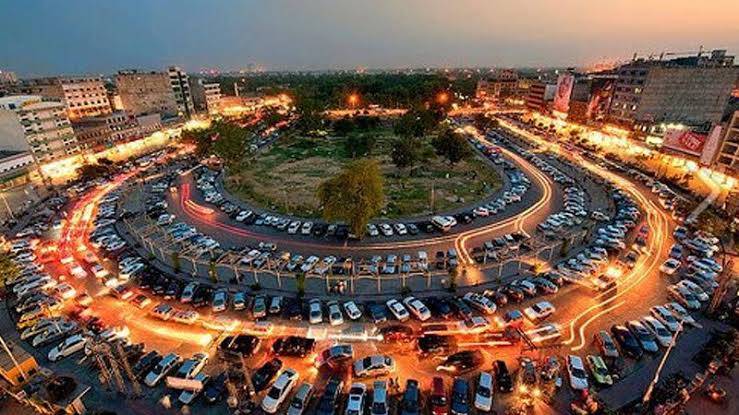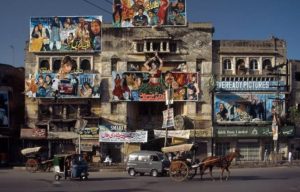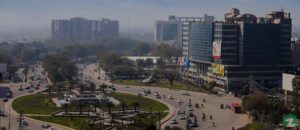
The Abbot road in Lahore is a spectacle or at least it was in the 1980s and 1990s. Most of the millennials and the post-millennial young people from the middle, upper-middle-class of Lahore do not know the place at all. The Abbot Road and Lakshmi Chowk on Montgomery road – a kilometer away were the hubs of Lahori entertainment. It was recognised as the place to visit on weekends – the center of swag in Lahore or dare I say the MM Alam road and Mall 1 of the 1980s. Teenagers and adults used to gather at the Pakistan Television office for the Tariq Aziz Show. With PTV being the only Broadcast channel in the country back then, celebrities such as Nusrat Fateh Ali Khan and Noor Jehan to prominent politicians were regularly seen in that area.
The place provided the then most popular quality of Lahori food, Tabaq restaurant, and infamous Kashmiri chaye to name a few. Couples and families used to wait for the screening of top movies at Gulistan-e-Cinema. It was a norm for the students of University of the Punjab, Government College University, and King Edward to hangout near Gulistan-e-Cinema to visit cheap burger places, long before the era of McDonalds and Howdy. This was, it really was – watching a movie on any of the abbot road cinemas; a night out near the famous Kashmiri chaye place; mingling with heavyweights and; eating dessert on Mall Road was all the Razzmatazz.

20 years on and it all started to change. The expanding middle and upper-middle class of the ’90s and early 2000s have shifted the entertainment center of Lahore. Increased investment, real estate development, newer restaurants sprung up away from the interior and old Lahore into areas like Gulberg, Defence, Model Town, Cantonment to accommodate the ever-expanding population. This was the time when wining and dining shifted to the new high-income areas with restaurant cuisines springing up from all over the world at Mall 1 on Gulberg Main Boulevard and MM Alam road earlier. But with the change in centers of entertainment for the Lahori elite, a massive change in the party culture took place; the avenues and methods of partying in Lahore’s well off have changed a lot since the ’90s.
This is where we see an incredible rise in the distinct western style partying culture that had encompassed this urban-middle and elite class. From Bedian farmhouse parties equipped with solid sound systems, loud music, alcohol, recreational and hard drugs to private clubs in Gulberg that offer a scintillating affair for the rich, high earning people to enjoy weekends and special occasions. It is fair to say that the above-mentioned benchmarks of Razzmatazz and Jazz have evolved, more so for the young adults than middle-aged. Alcohol and drugs have primarily captured the attention of the Lahore’s well off, upper-middle, and middle-class millennials (obviously not reflective of all) at a frequency unseen before.
It is equally reasonable to say one is likely to come across people of similar economic backgrounds, a particular brand of universities and schools namely Lahore Grammar School, Aitchison, LACAS, LUMS, LSE, and FAST in these types of gatherings. This generation of millennials is hard-pressed on a style of partying, Lahore hadn’t witnessed before. It is not to say that this wasn’t present in the ’90s or early 2000s but the sheer frequency and consistency with which it takes place now is definitively higher than before.

The underlying reasons for this change are multiple, least of which is the overwhelmingly large number of young people belonging to the families of industrialists, businessmen, white-collar professionals traveling abroad to study and coming back with western outlook and similar inclination for party and entertainment. This has led to institutionalised settings in universities, farmhouses, homes to accommodate this partying. Then there is the obvious factor of enriched mental freedom and opportunity to indulge in this westernised lifestyle stemming from western lifestyle and information. Furthermore, the expansion of the educated urban and upper-middle-class have altered the traditional forms of entertainment i.e. eating out or just going to a cinema. The obvious escape is clubbing, discos, substance intake and so on.
The other side of Lahore, mainly the vast majority of the monumental Lahori population that doesn’t formulate part of this class continues to stick to standard Lahori entertainment avenues. They have the reasons to visit interior Lahore – the sizzling Bhatti gate restaurants, the tea stalls at Lohari Gate, the Tabaq restaurant at Lakshmi chowk, and Gulistan-e-Cinema at Abbot road. It would be interesting to see this vast majority buying this new idea of entertainment in Lahore.
The place provided the then most popular quality of Lahori food, Tabaq restaurant, and infamous Kashmiri chaye to name a few. Couples and families used to wait for the screening of top movies at Gulistan-e-Cinema. It was a norm for the students of University of the Punjab, Government College University, and King Edward to hangout near Gulistan-e-Cinema to visit cheap burger places, long before the era of McDonalds and Howdy. This was, it really was – watching a movie on any of the abbot road cinemas; a night out near the famous Kashmiri chaye place; mingling with heavyweights and; eating dessert on Mall Road was all the Razzmatazz.

20 years on and it all started to change. The expanding middle and upper-middle class of the ’90s and early 2000s have shifted the entertainment center of Lahore. Increased investment, real estate development, newer restaurants sprung up away from the interior and old Lahore into areas like Gulberg, Defence, Model Town, Cantonment to accommodate the ever-expanding population. This was the time when wining and dining shifted to the new high-income areas with restaurant cuisines springing up from all over the world at Mall 1 on Gulberg Main Boulevard and MM Alam road earlier. But with the change in centers of entertainment for the Lahori elite, a massive change in the party culture took place; the avenues and methods of partying in Lahore’s well off have changed a lot since the ’90s.
This is where we see an incredible rise in the distinct western style partying culture that had encompassed this urban-middle and elite class. From Bedian farmhouse parties equipped with solid sound systems, loud music, alcohol, recreational and hard drugs to private clubs in Gulberg that offer a scintillating affair for the rich, high earning people to enjoy weekends and special occasions. It is fair to say that the above-mentioned benchmarks of Razzmatazz and Jazz have evolved, more so for the young adults than middle-aged. Alcohol and drugs have primarily captured the attention of the Lahore’s well off, upper-middle, and middle-class millennials (obviously not reflective of all) at a frequency unseen before.
It is equally reasonable to say one is likely to come across people of similar economic backgrounds, a particular brand of universities and schools namely Lahore Grammar School, Aitchison, LACAS, LUMS, LSE, and FAST in these types of gatherings. This generation of millennials is hard-pressed on a style of partying, Lahore hadn’t witnessed before. It is not to say that this wasn’t present in the ’90s or early 2000s but the sheer frequency and consistency with which it takes place now is definitively higher than before.

The underlying reasons for this change are multiple, least of which is the overwhelmingly large number of young people belonging to the families of industrialists, businessmen, white-collar professionals traveling abroad to study and coming back with western outlook and similar inclination for party and entertainment. This has led to institutionalised settings in universities, farmhouses, homes to accommodate this partying. Then there is the obvious factor of enriched mental freedom and opportunity to indulge in this westernised lifestyle stemming from western lifestyle and information. Furthermore, the expansion of the educated urban and upper-middle-class have altered the traditional forms of entertainment i.e. eating out or just going to a cinema. The obvious escape is clubbing, discos, substance intake and so on.
The other side of Lahore, mainly the vast majority of the monumental Lahori population that doesn’t formulate part of this class continues to stick to standard Lahori entertainment avenues. They have the reasons to visit interior Lahore – the sizzling Bhatti gate restaurants, the tea stalls at Lohari Gate, the Tabaq restaurant at Lakshmi chowk, and Gulistan-e-Cinema at Abbot road. It would be interesting to see this vast majority buying this new idea of entertainment in Lahore.
